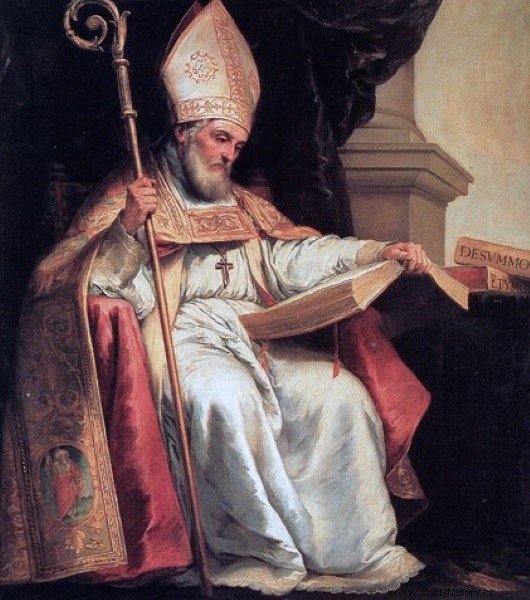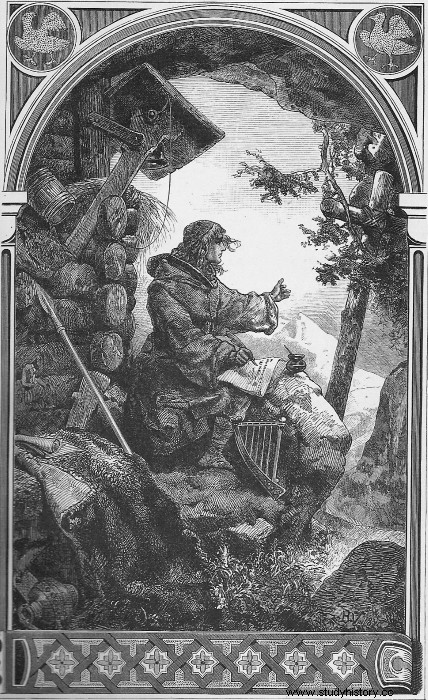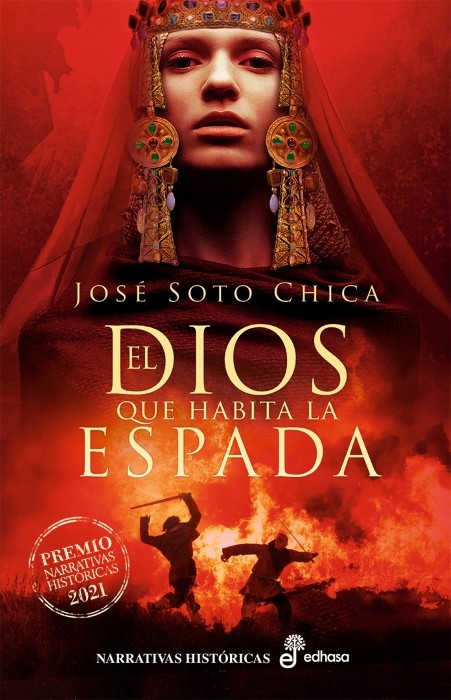
Year 568. The Visigoth kingdom of Toledo is engulfed in a deep social, economic and political crisis. King Atanagildo had died without leaving a clear heir. Meanwhile, his wife Gosvinta was left a widow and at the head of one of the most important Gothic factions of the Visigothic state. But of course... a woman cannot be in charge of it, you have to look for a king. Winds of civil war blow. After five months of noble deliberations, the Gothic warrior nobility elects a successor. The position would fall to the brilliant Liuva, a count of Septimania who, with a firm hand and determination, had kept the northern border of the kingdom intact against the push of the Franks.
The first decision of the new king was to send his brother Leovigildo to Toledo, to take charge of Hispania and Gosvinta. A Hispania that the Romans had left orphaned and sheltered from the towns that broke the Germanic limes, on that night of December 31, 406. Since then, Hispania has been adrift. When Leovigildo arrived, many Hispanic cities and regions functioned completely autonomously. The richest, in the hands of Hispano-Roman landowners, prevented economic resources from reaching the coffers of the Visigothic kingdom. A kingdom that, by the way, had lost its royal treasure during the assault on Córdoba, the ancient capital of Roman Baetica.
Leovigildo had it clear. Kingdoms could only grow and consolidate through arms, and he was a warrior, the best leader the Visigoths had known in their recent history. First, he ended a large part of the internal opposition, many of the nobility factions that opposed his power began to disappear. After clearing the way, the time of the conquests arrived:Orospeda, Corduba, Vascones, Cantabria, Sabaria, Asturians, Swabians; as mathematicians say, the order does not alter the product. He only left the Byzantine-Roman province of Spaniae for the display of his successors.

The Iberian Peninsula before Leovigildo.
In summer the sword and in winter the pen, that was the reign of Leovigild . A kingdom is achieved and consolidated with the sword that gives the necessary economic resources to form a state. But it only stays with the pen. Leovigildo legislated to create internal cohesion, allowing marriage between Goths and Hispano-Romans was his great legacy. In addition, Leovigildo created the necessary political-administrative structures to strengthen the monarchical institution, and in the process subtract power from the dangerous Gothic nobility. The example was very close, the province of Spaniae. Leovigildo not only dreamed of a kingdom, Leovigildo aimed higher, Leovigildo wanted an Empire.
You will be with me, the Leovigildo story is a story that needs to be told.
The God that inhabits the sword.
On March 25, the winner of the IV Edition of the Editorial Edhasa Historical Narrative Awards was announced. . An award that with only four editions has been acquiring great prestige among readers of historical novels. The award-winning novel was The God Who Inhabits the Sword , by José Soto Chica.
What do you want me to tell you? For any history lover, that looked great . Since, in 2010, Guillermo Galván will publish his "Shadows of the butterfly", there have been few, if any, historical novels that deal with the reign of Leovigildo. If I am wrong, I will be fully grateful if readers correct me.
But what was most attractive about that novel was the signature it bore. Jose Soto Girl , the historian from Granada, is one of the great specialists of this country in that historical period, halfway between the fall of the Western Roman Empire and the creation of the great medieval kingdoms of Western Europe. His Empires and Barbarians , has quickly become one of the reference works of that period. A period, by the way, as exciting as unknown, despite the enormous work of the historians of this country. Where historical sources are really scarce, those of us who are passionate about history need to visualize the facts through the prism offered by the literary genre of the historical novel . A genre that we never forget, that we have to try to read with a magnifying glass. For this reason, I was fundamentally attracted to José Soto Chica's publication.

José Soto Chica with his «Empires and barbarians»
Those of you who usually read the posts on this blog will have seen that I personally tried, prior to reading it, to put the magnifying glass on The God Who Inhabits the Sword . Yes, because Leovigildo's reign cannot be understood without knowing the figure of Queen Gosvinta.
In the relationship between Gosvinta and Leovigildo we will find the idiosyncrasies of the Visigothic world. Families and lineages constantly in conflict for power . Leovigildo had his own weapons, his sword and his great determination to become emperor of Hispania. Gosvinta also had his own, intelligence, perseverance and excessive ambition.In the minds of those two characters there was only one thing:power, power and power . Their relationship was the quintessence of Morbus gothorum , as the Gallic bishop and historian Gregorio de Tours defined that Gothic custom of cutting the throat of anyone who interferes with your plans. The "good" Leovigildo must have been more afraid in bed with Gosvinta, than in the midst of any of the many battles to which her ambition invited him.
La Gosvinta by José Soto Chica It lives up to expectations, in several passages of the novel the fascination of the Granada historian for this essential figure in the history of the Visigoth people can be glimpsed. Lately, and I have also noticed in this blog, I have enjoyed reading various essays on the Roman empresses, recapitulating them, he asked me; How much of Agrippina the younger did our Gosvinta have?
The Battle of Peña Amaya or Amaia.
Jose Soto Chica's narration transports you to the historical period in a masterful way. As a lover of the literary genre, and a continuous apprentice, the staging of historical places of which we only have four unconnected data, is one of the greatest difficulties of the historical novel writer. From José Soto Chica I was expecting his magnificent descriptions of all aspects related to the Byzantine world, or the Eastern Roman Empire, as they like today, to name the Empire of Constantinople, not in vain in one of the greatest experts, not only in Spain, but I would dare to say of the world in relation to it. I assure you that, with The God who inhabits the sword You will enjoy a magnificent description of the Byzantine ceremonial, which Leovigild incorporated into the Visigoth kingdom of Toledo.
In the same way as Constantinople or Toledo, we will visit other ancient cities left by the Romans. The description of the siege of Híspalis is sensational. Also noteworthy is the visit to Corduba, the ancient capital of Roman Baetica, and the place where Valtario, the main protagonist of the novel, begins as a Gothic warrior, yes, he is not Leovigildo, I will tell you later... The port of Cartagho Spartaria, Tarraco, Arelate, the courts of the Frankish kings, and endless places that I am forgetting. But there is one that I neither want nor can forget. Peña Amaya .

Entrance to the Peña Amaya castro.
I visited three years ago, it was the end of summer and late in the afternoon. It is the typical place that those who are not passionate about history tell you; "That's a scree, there's nothing."
True there is nothing, or rather some unconnected foundations of the old facilities of one of the most important forts in the history of the Cantabrians, but it is a place with a special magic to dream of history. In the middle of that enormous plain that watches over the great Castilian plain, there is a small booth where I met the area watchman, who explained to me that they had been waiting for years for the archaeological intervention of the place. Gentlemen of the Junta de Castilla León, please do it now. Reliving that place conquered by Leovigildo from the Cantabrians is one of the best memories that this reading leaves me with . It is not easy to do it, thanks José Soto Chica.
Valtario, the god of war.
The God that inhabits the sword it is also a novel of profound characters. Along with Leovigildo and Gosvinta, the two sons of the Visigoth king stand out; Hermenegildo and Recaredo, two fundamental characters for the history of the Visigoth people and therefore for the excellent plot of José Soto Chica. The historian from Granada rescues all of them from the few historical sources to give them a life of their own. They are obviously in good company; the frank princesses , currency to keep the peace between barbarians, as the Romans called Visigoths and Franks. The storytellers , the great sources for the knowledge of the Visigothic period also pass through the pages of this novel; Juan de Biclaro, Isidoro de Sevilla or his brother Leandro.

Saint Isidore of Seville
There is another series of historical figures, whom José Soto Chica deftly slides through his narration to make you fall in love with them. Of course, Millan he is one of them, the hermit who with his century on his back and on his mule directs Leovigildo to become the most powerful king of Hispania. A role as short as it is fascinating is the one given to Sigeberto , the Frankish king married to Gosvinta's daughter, Brunequilda. When you meet him, you will think that it was not so hard to be an early medieval king. But the one that really stands out and falls in love line after line is Baddo , a girl without a past, who became a Visigothic queen after her marriage to Recaredo.
But for all of them to have a place in The God Who Inhabits the Sword they had to find a common link, it could not be other than Valtario , the god of war, is the great fictional character born in the mind of José Soto Chica.
Although Valtario is not a real character, Valtario is the legendary hero that all towns need. In the 10th century, a medieval German monk wrote about the deeds of Whaltharius, during the period of Visigothic settlement in French Aquitaine in the 5th century.
José Soto Chica's Valtario was born in one of the greatest defeats suffered by the Visigoths in Hispania . The day that the army of the late Roman landowners of Corduba, supported by Byzantine troops, inflicted such a painful defeat on the wet streets of the Roman capital of Baetica, Valtario was thirteen years old. There he learned how terrible war was, there he lost his best friend, the son of the Visigothic king Agila, and there he chose which would be home, war. A character spun with threads of blood by José Soto Chica, I assure you that it is very difficult for me to explain in words, what the author makes you feel in the maelstrom of a battle through Valtario.

Engraving of Waltharius
Yes Valtario is war personified, his wife Lucila he is the other masterly fictional character that the author brazenly uses for a purpose; give us the historical key to the consolidation of the Visigoth Hispanic Kingdom. Lucila is the daughter of a rich late Roman landowner from Corduba , her union with Valtario, the best Visigothic warrior, is metaphorically the origin of Visigothic Hispania. Hispania could only exist with the Visigoth sword and the Roman solids . It is true that later the more religious aspect would enter the fray, Arians against Nicaeans, but this aspect, if we read between the lines of the novel, went into the background.
I don't want to close this brief chapter on the characters without giving my one little slap on the wrist to José Soto Chica. Although making it clear that he is the teacher and I am his most faithful student . Was it necessary to make Hermenegildo so "bad" to make Recaredo so "good"?
Afterword.
In the previous paragraph I gave one of the keys to this novel. José Soto Chica is a historian , and, furthermore, even if I repeat myself, one of the best in this country in the Visigothic period.
The God that inhabits the sword It is more than a good historical novel that, if we have to classify it, we would place it halfway between adventure, war and biographical novels. José Soto Chica's narrative is fluid and to some extent electrifying and addictive. It is not a short novel, but the pages turn quickly in a continuous search for answers.
But, also, as I have said, it is a novel that you have to dedicate yourself to reading between the lines, in that place you will find excellent history lessons. Because as it says in its author's notes, it is a historical period where we only know the surface, which is why it is very difficult to understand the process of consolidation of the Visigothic Kingdom. A process in which many social, economic, religious and political factors intervene. A process, where in addition to the Gothic people, the Hispano-Romans, the Eastern Romans, the Franks and a large part of the Mediterranean peoples intervened.
Thank you master, for this magnificent illustration on the life of Leovigildo, Gosvinta, Hermenegildo or Recaredo. Thank you also for your wonderful history lesson putting the named factors in order. But, above all, thank you for your Valtario . A character that you make to be as or more real than those mentioned above, in short, was called Valtario, or in another way, in the formation of Hispania there had to be a man who wielded the sword where the God of war lived.

The god that inhabits the sword in Historioteca
